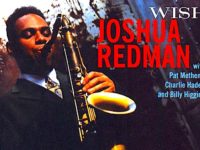Funny what an early end does to a legacy. Doomed geniuses are always better off, accolade-wise. They make their mark, even if it is ever so fleeting, and that moment is examined by fans-turned-archaeologists for generations. Pity the poor soul, then, who keeps at it. Who remains vital, unparalleled and upright.
Sonny Rollins was that man. Still out there playing when Road Shows Vol. 1 arrived in October 2008, he had kept at it – touring incessantly, looking for that perfect note, neatly blending the concepts of show and seance. Yet, until then, precious few of his more contemporary moments had drifted out beyond the walls of those concert halls.
Turned out, Rollins had been dragging along some recording equipment. Better news still: As many as one third of the approximately 600 shows he’d done since the late 1980s were suitable for release, free of either legal entanglements or unforeseen technical issues.
This 2006 set in Toulouse stuck in Sonny Rollins’ mind. After all, he’d thought to include “More Than You Know” for the first time since recording it with Thelonious Monk in the 1950s. There was also that stuff from a year later with bassist Christian McBride and drummer Roy Haynes, done at Carnegie Hall as part of his 50th anniversary concert, from which Rodgers and Hammerstein’s “Some Enchanted Evening” is culled. Together, they make up the cornerstones for Road Shows Vol. 1, a compilation of rare Rollins sides put together by the tenor man for his Doxy label.
A notable trio of cuts also come from collector Carl Smith’s archives, including 1980’s “Blossom,” a little known original, and a 1986 version of “Best Wishes” from Tokyo. Elsewhere, Rollins unveils an hour-long 2006 festival performance, captured by a French television crew, that nicely highlights both his searing on-stage brilliance but also some revealing behind-the-scenes moments. That became the In Vienne DVD, issued simultaneously with Road Shows Vol. 1.
These releases, framed as the first in what was to be a series of dusted-off gems, underscored not only the dominance of Sonny Rollins as jazz’s most important living saxophonist – but also of the music’s ability to transform itself concert after concert after concert in the hands of a peerless innovator: “A different sunset every night,” Rollins once said, “that’s what jazz is about.”
So, why isn’t Rollins more celebrated? Perhaps it’s because of his propensity to take some time away. After all, Rollins disappeared from the charts at the peak of his powers for three years beginning in 1959 (legends tells us he was workshopping his sound on Manhattan’s Williamsburg Bridge), and then again in the late 1960s. Or maybe, it’s because Rollins never did completely disappear, somehow avoiding that inevitable twilight: Unlike the romantic, though so often ultimately tragic heroes of his genre, Rollins lived to a ripe old age. I always thought that was the difference in the popular conception, say, of Dizzy Gillespie versus Charlie Parker.
Through embryonic triumphs as part of the early ’50s-era Max Roach-Clifford Brown Quintet (speaking of those gone too soon), 1956’s Saxophone Colossus (featuring his eventual calypso standard “St. Thomas”), the well-regarded ’60s score for Alfie, important 1970s output for Milestone on through to the Grammy-winning performances of 2000’s This Is What I Do and 2004’s Without a Song (The 9/11 Concert), Sonny Rollins remained transcendent, if perhaps never truly revered. Recording for six decades, it seems, has its drawbacks.
Road Shows Vol. 1 and In Vienne were then, and remain now, a fresh chance to revisit one of jazz’s genuinely underrated figures, to hear again what made Rollins the most important living heir to the gumption so closely associated with John Coltrane. And in the perfect setting, too: Rollins always inhabited the stage more completely than he did any studio, unleashing time and again something jazz writer Stanley Crouch rightly described as “emotion, memory, thought, and aesthetic design.”
These road shows, so fierce and relevant, found Sonny Rollins standing as a colossus once more.
- The Bright Spots in George Harrison’s Troubled ‘Dark Horse’ Era - December 29, 2024
- The Pink Floyd Deep Cut That Perfectly Encapsulates ‘The Wall’ - November 29, 2024
- Why Pink Floyd’s ‘The Endless River’ Provided a Perfect Ending - November 11, 2024


